Straw mulch vs. hay mulch: In the battle to control weeds, add fertility, and improve the water retention of your soil, is one really better than the other? Well, in a word . . . yes!
Straw Mulch vs. Hay Mulch: What’s the Difference?
Let’s start at the beginning. What is the difference between straw and hay? Or are they essentially the same thing?
Many people think they’re identical because they’re both often tied into square or rectangular bales, but a closer look reveals that they’re actually quite different. Understanding these differences may help in your decision about which material better suits your gardening needs.
Characteristics of Straw
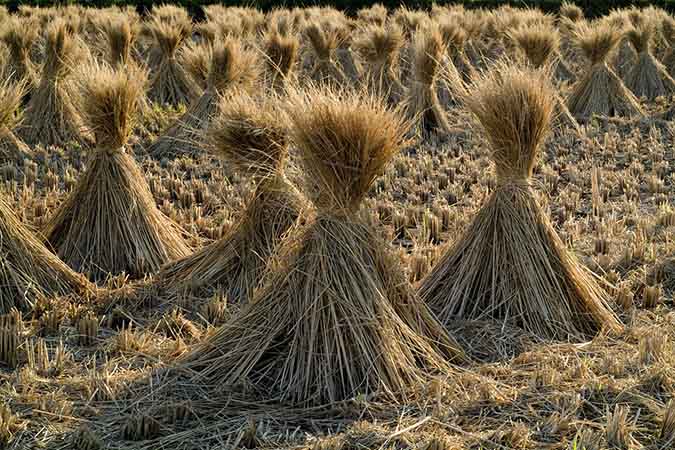
Image by David Mark from Pixabay
Straw is the stalk of a cereal crop such as oats, barley, wheat, or rye after harvesting has removed the seed heads.
Usually a big machine called a combine harvester will come along into the field. In one smooth operation, it chops off the top portion containing the grain and sends the grain in one direction for processing, and then cuts the straw and collects it until a bale-sized block is formed.
The straw bale is automatically tied and is then dropped out of the machine, back onto the field for later collection.
You May Also Enjoy:
“How to Make Fish Emulsion Fertilizer”
“A Simple Fertilizer From the Greek Gods” (Fertilize with Beer and Milk)”
“Jump-Start Your Compost With These 5 Free, DIY Compost Activators”
In many parts of the world, straw is seen as a waste product—a secondary by-product of the cereal crop—and is sold for practically nothing.
But where I live in Nova Scotia, Canada, it is actually more expensive to buy straw than it is to buy hay, because not much straw is produced locally. What straw we have is quickly purchased for animal bedding. We just don’t have the climate for mass cereal crop production.
Characteristics of Hay
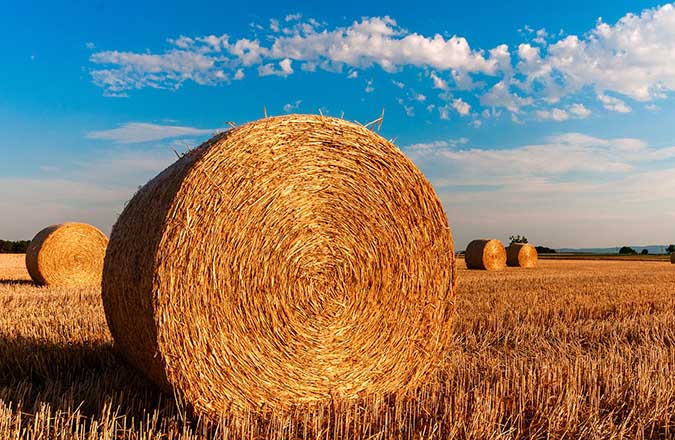
Hay refers to grass that has been cut while green, dried, and then made into square or round bales. Hay is used mainly for feeding animals when no fresh grass is available. It provides bulk, fiber, sugar, and nutrients to animal diets.
The best hay smells sweet, and if you take a handful and get it wet, it still looks like grass. (Straw has an almost exclusively yellow color when it is baled, and just a hint of a smell.)
Hay bales can look like a greenish coarse grass, fine grass, or even flowery and weedy grass; it entirely depends on what plants were cut and dried to make the bales. The quality can vary hugely depending on the skill of the farmer making the bales and the quality of his hay fields.
It is very important to get hay that has been dried to the optimum level, so that it’s not crumbly but is dry enough to discourage mold growth. Overly dried hay starts to compost quickly when it is damp, and composting hay bales have been known to heat up and start barn fires.
Straw Mulch vs. Hay Mulch
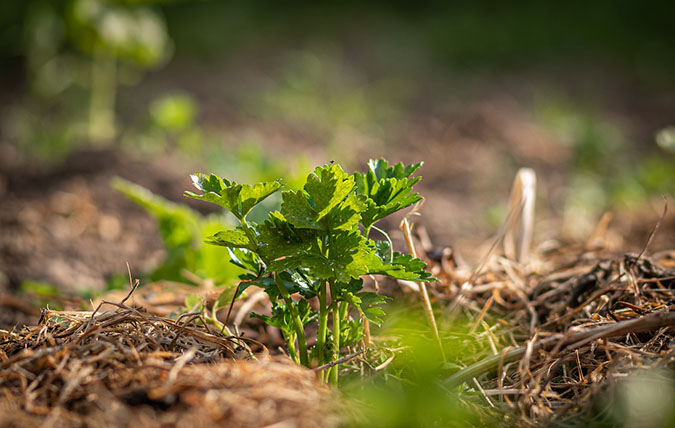
Image by Andreas Göllner from Pixabay
So now that you know the difference between straw and hay . . . why would you choose one over the other for mulching your garden? I mean, it’s just mulch, right?
The benefits of mulch in a garden cannot be overstated and, if you’re reading this article, I assume you already know how terrific it is for controlling weeds and providing walkways.
A good mulch also helps the soil to remain cool and moist longer in summer and can insulate the soil in colder weather. Mulch creates a microclimate over your soil by essentially acting as a blanket to protect it from the harsh drying effects of the sun and wind.
All mulches perform this action, including our straw and hay—but did you know that other mulches used around the world have included wood chips, bark, pine needles, shredded leaves, and even rocks?
Yes, rocks.
The inhabitants of Easter Island recognized that mulching prevented the wind and rain from eroding the valuable topsoil, so they used volcanic rocks spaced out on their fields as a lithic mulch to slow runoff and wind erosion. (But I can’t imagine most of us deliberately placing rocks in the garden, can you? I know that in my own garden, I’m constantly doing the opposite, because every year my garden seems to grow a new supply of rocks.)
You May Also Enjoy:
“Sheet Mulching: Build Soil, Thwart Weeds, and Make Your Garden Fertile”
“Grow a High-Performance Garden, Episode 10: ‘Mulching Time!'”
Surely some of these mulching methods work better than others, wouldn’t you think? Do some work better in areas of wind or rain? Are some better suited for slopes? What about availability? These are all questions you need to answer for yourself. Then, experiment to see what actually works for you.
Planning is a huge part of having a successful and productive garden over the long term. You should choose the location wisely, taking into account the sunlight, type of soil, and climate.
But, in reality, most of us just have to use whatever we’ve got. Not everyone has 20 acres and can pick the perfect spot. So, let’s just say that you are growing in a typical home garden and the mulches you can most easily and economically get are hay and straw.
Straw Mulch
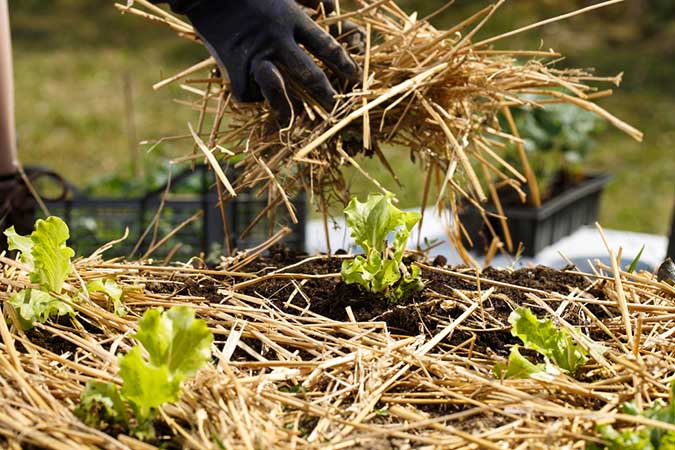
Straw mulch in garden beds
The Pros of Using Straw Mulch
Straw is a terrific insulator. The hollow stems retain air and their chopped, light, fluffy texture allows for easy spreading. In fact, the principal uses for straw in the U.S. over the past 200 years have been as animal bedding, for insulating walls in homes (or building straw bale houses), and for covering the ice in ice houses to act as insulation so that the ice is available for use during the summer.
You May Also Enjoy:
“How to Sheet Mulch for an Abundant Garden”
When used in a garden, it also tends to remain lighter and fluffier than hay, and it keeps a beautiful golden appearance for quite a long time.
The surface remains dry even as the lowest layers touching the soil begin to decompose. Have you ever picked strawberries in a field? Almost certainly there was straw around the bushes and it gave you a good clean place to sit or kneel that felt soft and cushioned.
The Cons of Using Straw Mulch
Straw can be expensive depending on where you live, and you might not be able to grow it yourself. Straw can also act as a home to rodents because of its fluffy texture. It has a higher tendency to blow away in strong winds when it is first laid, unless you try very hard to pack it down.
Straw does add some bulk to your soil, but it is mostly composed of cellulose and fiber that are left over after the plant puts all its nutrients into the seed heads that were harvested for grain. Consequently, straw adds fewer nutrients back into the soil when it decomposes, and soilborne bacteria tie up the available nitrogen for a longer time to break down the tougher stalks.
You May Also Enjoy:
“35+ Powerful, Inexpensive Organic Fertilizers You Can DIY”
“Homemade Fertilizers—15 Simple and Inexpensive Options”
“Aerobic Compost Tea, Worm Tea, and Leachate—A Clarification”
Because straw is fluffier and makes less direct contact with the soil, it takes longer to decompose . . . which is both a plus and a minus. If you want to add nutrients, this is a minus, but if maintaining a cover or walkway is important, then it’s a plus.
Blown-in weeds won’t land in a moist environment and sprout but, on the other hand, in-ground weeds are more easily able to push through a straw mulch from the bottom due to its fluffy nature. You can counteract this effect by weeding, putting down some newspaper before laying the straw mulch, and using a thicker layer—perhaps 8 inches thick or more—to provide a darker environment that most weeds simply don’t have the energy to get through.
Hay Mulch
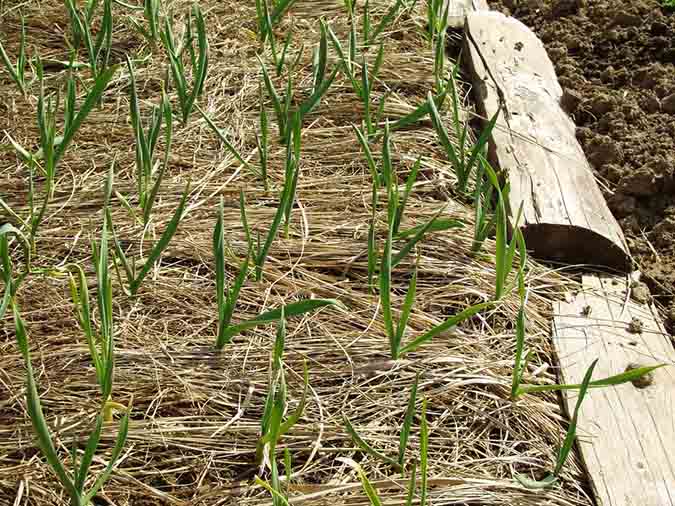
Hay mulch, with winter garlic sprouts growing through
The Pros of Using Hay Mulch
Hay is readily available and it’s possible to get a scythe and cut your own if you have a grassy area on your property. You don’t need to bale it—just cut it, let it dry, and then fork it into your wheelbarrow and wheel it over to where it’s needed. Even long grass clippings can function the same way as hay, because they’re essentially the same thing.
Learn how to create the vibrant soil you’ve always wanted with our exclusive Compost and Soil Fertility Toolkit—featuring 32 expert-led trainings that cover everything from compost and soil detox to worm farming and the Mittleider Method. Click Here to Grab a Huge Bundle Discount on the Compost and Soil Fertility Toolkit!
Hay left over from a previous year is often considered garbage by farmers who want to feed their animals the most recent and more nutritious hay. Consequently, hay is sometimes available for free during hay season in the summer.
You May Also Enjoy:
“5 Inexpensive, Simple Solutions For Small-Space Composting”
“6 Organic Nitrogen Fertilizers for Healthier Soil”
“Make Peace With Your Poop (and Then Make Compost With It!)”
You can find it by looking at your local online advertisement site, such as kijiji or craigslist, or by asking your farming friends.
Hay contains a variety of grasses and legumes, plus often clover and other flowers (including both the leaf and stalk), so the plant nutrients are all there.
When hay decomposes, it adds significant nutrients to the soil to increase its fertility. It adds a balanced ratio of NPK, as well as all the trace minerals that were contained in the plant.
Hay tends to lay flat and pack down, so it decomposes fairly quickly.
It also has more of a sponge effect than straw does, which means that in heavy rainfalls, it buffers or slows down the amount of rain that soaks into the soil to help prevent erosion and leeching of nutrients.
Because hay packs down densely, the weeds from underneath get smothered and die very quickly. But weed seeds that blow in can sometimes sprout, especially in an older hay mulch that is very damp.
The Cons of Using Hay Mulch
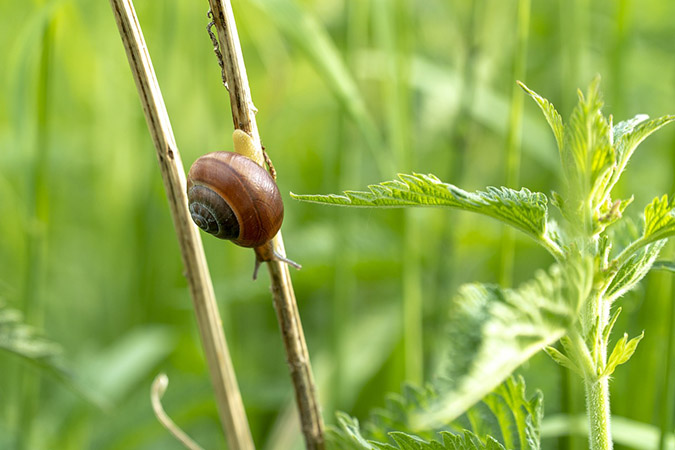
Hay mulch has a tendency to attract snails and slugs in rainier climates.
In moist parts of the world, hay mulch has more of a tendency to harbor slugs and snails, so you need to keep a good eye out for them and have a method of removal ready.
Hay generally doesn’t harbor mice, because it’s too dense. Hay takes on a packed and spongy texture that holds water, so sitting after wet weather is likely to leave you with a wet bum.
Hay holds moisture, allowing seeds on top to sprout, which is why some consider hay bale gardening to be such a great thing. But if you’re trying to suppress weeds, do you really want this? And often the hay itself contains seeds that will sprout once they get wet, so you could end up with a living pathway until the dry weather dries out the topmost layers of your mulch again.
You May Also Enjoy:
“Straw Bale Gardening: How to Succeed”
As hay decomposes, it is broken down by various bacteria and other organisms that all use nitrogen, just as we discussed for the decomposition of straw. So what happens is that these organisms get a new food source (your hay compost) and they multiply rapidly, which depletes the soil of nitrogen. As they run out of food, the organisms die and the nitrogen is once again available for the plants to use.
So planting directly into a hay mulch without any supplemental nitrogen source available probably isn’t the best idea.
Which Should You Choose?

Now that you know more about hay and straw as mulches, which one are you going to choose?
The Perfect Solution
In a perfect world, the solution is to use both—a thick layer of hay mulch on the bottom, where it will decompose and act as a spongy reservoir for moisture, topped off with a few inches of straw that will be a dry layer, preventing blown-in weeds from sprouting and giving you a lovely, dry, golden walkway.
What If You Can Only Use One?
But we don’t all live in a perfect world, do we? We’re just trying to make the best of what we’ve got, and that’s what makes a great gardener or homesteader—the ability to problem-solve. So, I’d suggest that if you have a choice of only one type of mulch, you use hay simply for the fertility it will add to your soil.
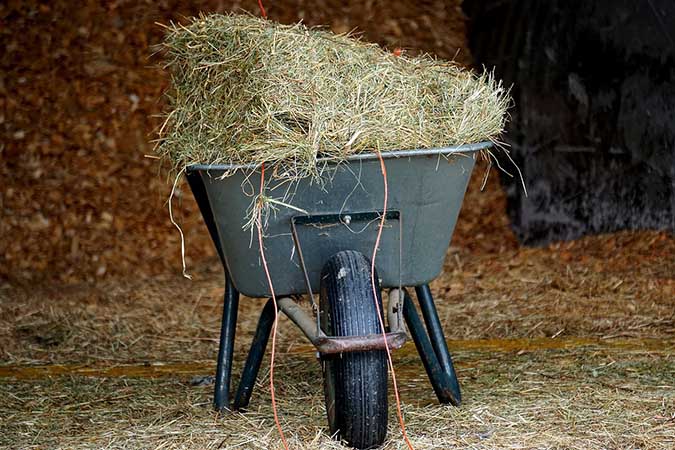
Use hay mulch instead of straw mulch if you can only choose one. If you can use both, do.
As all practical gardeners know, you use what you have or can easily get. Why pay money for straw if a local farmer will give you hay in July for nothing? If you can get it free, but you don’t need it all at once, then simply put the extra bales out by your garden, throw a tarp over them, and save them for next year.
If the hay gets wet and starts to compost itself, it really doesn’t matter. It’s all going in the soil in the end anyway, and the pile of bales can act as a windbreak while it waits to be used.
Your Evolving Garden
A garden is a living, breathing thing. It evolves from year to year and, as gardeners, we are the stewards of the fertility that is in our soil.
It depends on us to pay attention and make sure that we don’t take out more than we put back in. After all, we want our gardens to feed us for many years to come and to be places where we can teach our children and grandchildren the mysteries of growing their own food, too.
You May Also Enjoy:
“Special Challenges to Managing NPK in the Organic Garden”
Gardens are places where families and communities come together to work, talk, and visit, so we should try to make sure that, in addition to teaching the value of work, we also find pleasure in being outdoors.
Planning the best method of mulching your garden is important for fertility and moisture retention, and it will also significantly reduce the amount of time you spend watering and weeding, which will in turn increase your enjoyment of your garden.
A well-mulched garden also makes better use of the precious water resources that are becoming scarce in so many places. As a fellow gardener, I encourage you to try new things and experiment with mulches to see what works for you. But most of all, have fun in the garden!
What Do You Think?
What is your favorite mulch to use in your garden, and why? Do you have any other tips for getting mulching materials inexpensively or for free? Let us know in the comments!
__________________
The Grow Network is a participant in the Amazon Services LLC Associates Program, an affiliate program designed to provide a means for our team to earn fees for recommending our favorite products! We may earn a small commission, at no additional cost to you, should you purchase an item after clicking one of our links. Thanks for supporting TGN!
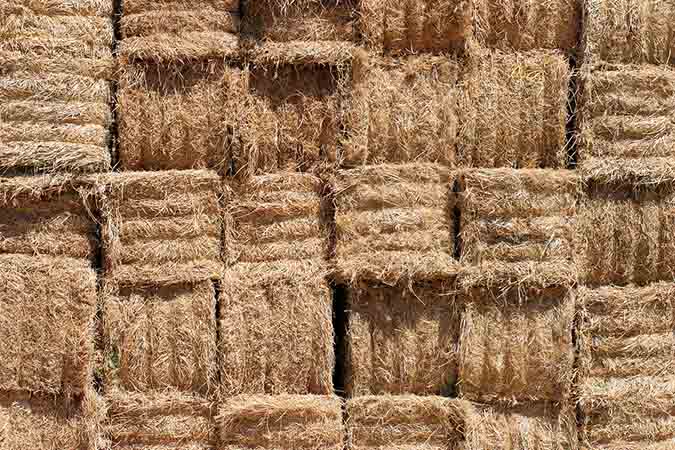
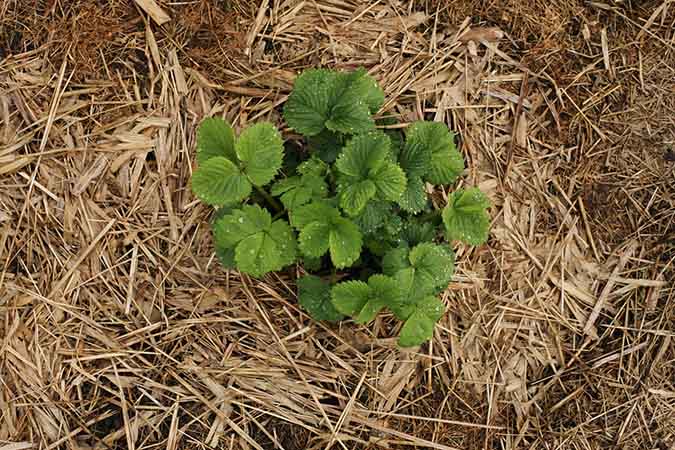







COMMENTS(14)
This article is well written and informative. This year I did buy a straw bale for mulch among tomatoes and peppers with satisfactory results. In the past I have used both hay and straw in the garden. The “cleaner” you can get straw (few weed seeds) the better. I found with hay, there will always be more weed seeds which simply have to be attended. Even so, it can be a good mulch. I once tried to grow potatoes in heavy hay mulch. The potatoes grew well but were damaged somewhat by centipedes drawn to the damp mulch. Articles like the this one are an excellent help in trying to get the best information on gardening. Good job!
Thanks. I’m glad you found it useful.
Practical use for rock mulch is strawberries on a steep hillside. This works very well for me. As they send out runners after fruiting I tuck them in the good soil in the crevices between the rocks. The berries stay clean and the cat sleeps on the big rock and keeps the birds away.
I use hay that I cut from my fields for mulch to feed the soil but then I cover that with discarded carpet. It is an 8 foot wide expanse of carpet between the row and the fence but the vines are already climbing the fence mid July. A 4 foot strip of carpet keeps the raspberries from coming up in the pathway. I roll it up, add more hay and roll it back out. Seeds in the hay rot under the carpet. The rain goes through and the man made fibers dry quickly but the moisture is protected from the sun and wind by the carpet. Ask a carpet installer they will often deliver it free rather than pay the dump fee.
I raise goats, chickens and turkeys. The hay cycle begins with feeding the goats. They are picky eaters (believe it or not ), they eat about 33-50 % of the hay and toss the balance aside from the hay rack. This becomes their bedding in the goat houses. The decomposition of the wasted hay, manure and urine provides a heated bedding during winter. This is moved to outdoor composting pad once the bedding reaches 4 ” in summer and 8-12 ” in winter. As the weather drains the top surface of pile of nutrients to core, it becomes more like dry straw. This is transferred to poultry coops for nests and bedding material. Once this bedding is built up, it gets moved to compost pile. The compost gets sent to gardens for spreading after crop harvest to break down chopped crop biomass over winter. Come spring, it is turned into soil for planting season. I reserve some for mid season fertilizing mulch (aka; compost tea and mulch of unbroken-down biomass components). This helps give the plants the needed boost and moisture conservation during flowering and bulk growth. Straw I produce from cutting tall dried weeds and grain stalk is used as base for hay compost and garden weeds composting. I also use garden weeds compost for growing my potatoes in. After growing potatoes, melon/cucumber/squash is grown in it.
I started with 73 % clay soil 10 years ago. Today the clay content is about 48 %. My aim is 25-33% clay without going broke to get there. This year I had 3.5 tons (7 pick-up truck loads) to add to my 1/2 acre garden. I withdrew 1.5 tons of produce last year. This gives me a surplus of 2.0 tons of biomass to garden. Now only if the darn weather would cooperate!
Where in Nova Scotia do you live, Elizabeth? I live in Halifax and travel around the province regularly for my job. When time allows, I’d love to see your homestead.
wasnt aware there was a combine out there that worked that way 😂- maybe our equipment is just old and we’ve been working ourselves to hard…. 😵💫
With hay or straw mulch, beware of herbicides that were sprayed by the grower to kill weeds. Some are very persistant for years, and will kill your garden.
I’ve tried a lot of different mulches here in tropical northern Australia. We can’t get straw as grains aren’t grown up here and the hay is generally Rhodes grass. I’ve never had a problem with weeds in it and use it for bale gardening, creating a frame to contain grass clippings, fruit and veggie scraps etc while I grow veggies in the actual bales. Then the whole lot becomes compost by the end of a growing season. Sugar cane mulch is also popular; it smells lovely and is great for weed control, but tends to mat down a bit like grass clippings. The best I’ve found is peanut shell; it smells ok, looks good, being a nice neutral brown, and the worms LOVE it, but it’s expensive and not always available. I do use my grass clippings but mostly after they’ve been at least for a trip through the tumbler, otherwise they make a mouldy mat that excludes water quite effectively. Also here a lot of people swear by mill mud, a by product of the processing of sugar cane, but it’s not easily come by nowadays because of health and safety reasons, I think.
I live in SW Idaho and used to use a ton of organic and spray-free straw to enrich our very sandy soil. But I think that’s how I got horrible infestations of bindweed and cotton top – two of the most feared of all the weeds. My guess is that the grain fields were infested and the seed got picked up in some of the straw. So know which invasive weeds are growing in your area and whether the fields you’re getting your material from are clean before you put it down.
After five years of intensive battle, I’ve developed a trio of strategies that seem to be turning the tide. First, the straw bales must sit in the straw bale stack for two years before use, to expose any seed contained therein to heat, drought and aging. Then the straw is used to line the floor of the chicken barn for six months. Only then is it spread out, and then only in the orchard pasture so I can monitor for the effectiveness of treatment. I’m still in the verification stage of this process, but so far, so good.
The second part of my strategy is competition. Lambs’ ears is the one drought-tolerant plant I’ve so far found that seems able to muscle out and smother the cotton top and most of the bindweed. The lambs’ ears is aggressive, too, but lacks the hellish root system and, so far, the propensity to re-seed itself fro here to Timbuktu. Besides, it’s pretty, it feeds the pollinators, it’s evergreen and it has some medicinal uses.I would recommend this strategy for bounded/contained areas only, though, or you might wind up with a field of lambs’ ears just replacing the bindweed or cotton top. Make sure you dig out as much bindweed and cotton top root as you can before planting the lambs’ ears to give the ears the upper hand as they start growing.
Last but not least is 30% cleaning vinegar. Whenever I see bindweed or other aggressive/free seeding weeds, I peel back the bark mulch and let’em have it straight from the vinegar bottle. The smaller they are when I douse them, the better it works. For extensively- rooted monsters like bindweed, you’ll need to hit them over and over -and over again. Be prepared to use a LOT of gallons of vinegar to keep one small area clear. But I did this most of last summer and by mid fall they seemed to be getting exhausted and stopped returning. They’re still growing in areas where I can’t acidify because of the proximity of other plants, but in the open areas, so far they’ve stayed away as the colder, wetter weather descended. I have no idea if they’ll return in the spring but I’ve stockpiled vinegar in anticipation of hitting them just as soon as they try to poke their nasty little leaves out of the ground.
It requires specifically 30% cleaning vinegar to do the trick, though. If anybody else tries this, let me know how it works for you. It is NOT a “one and done” approach like spraying, but when the only alternative is to lose your property to nasty takeover, it’s worth the effort. Plus, it’s temporary so if you can get rid of the infection, you can start over once the soil returns to normal. Not perfect, but sure beats RoundUp.
The pacific NW is slug paradise…mulches are hard. Cocoa hulls are fabulous but too costly, carpets, cardboard, newspaper, seaweed and leaf mulch all tried and used….but the slugs! I’m going with cover crops like clover. I do normally have ducks to help with the slugs…but then again they have to be closely watched!